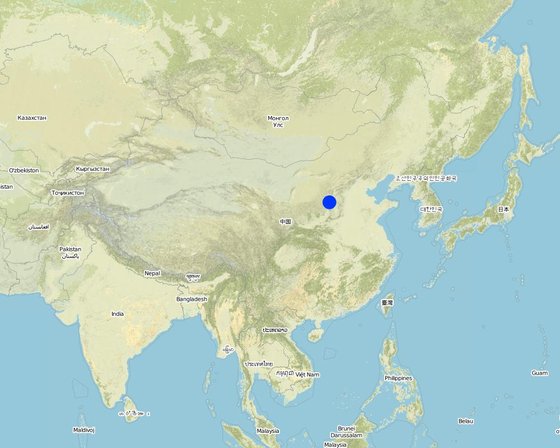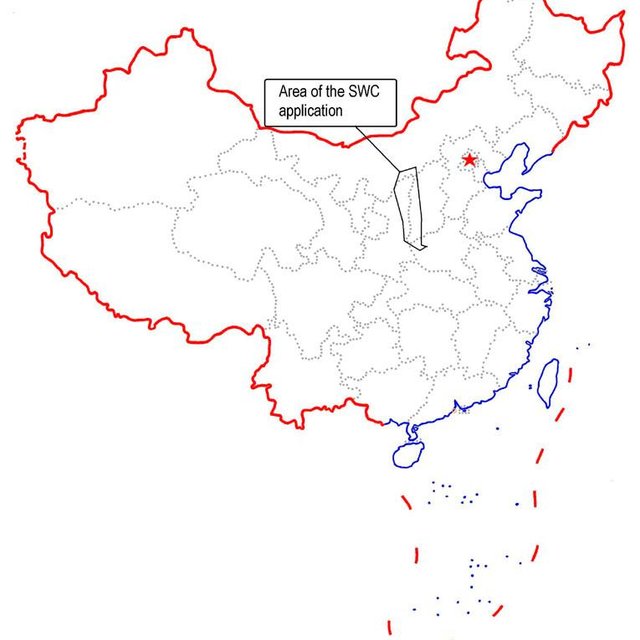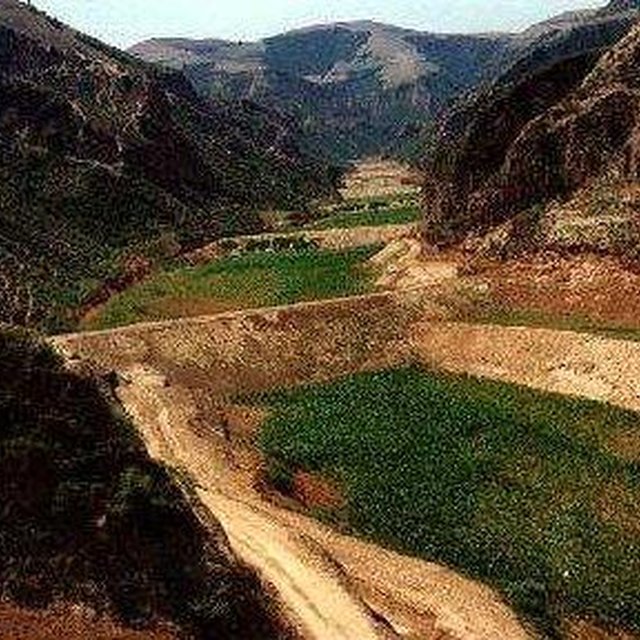Falling Water Dam
(China)
Descrição
The falling water dams are widely built in the middle reach of the Yellow River, the typical dams are filled with dense slurry by water flow from upland. The approach is implemented mainly by government investment.
Falling water filled dams distribute widely in the middle reaches of the Yellow River. They are used to store water, wrap sediment which results from soil and water loss. On the Loess Plateau, in addition to the conditions of deep gully and steep slope, earth above the top of the dams can be used to build dams. First, soil is loosed with squirt guns, explosion or manually digging. Then, water is pumped up to the loose earth so as to rush the soil down along transporting ditch, turning the soil into dense mud, to dams level surrounded by tamped banks. Under the press of gravity, the mud dehydrates, consolidates and becomes uniformly dense body of the dams. Compared with dams in other areas, the water power filled dams in the Yellow River basin are characterized by much denser mud, uniform particles and body texture, smaller transect of dams body, and wide applicability to soil materials such as sand soil, loess soil and weathering residue. The types of dams have widely applied to build middle and small reservoirs and silt arresters in the middle reaches of the Yellow River, playing an important role in agricultural production and reduction of sediment into the Yellow River.
Localização

Localização: Shanxi, Shaanxi, etc., China
Geo-referência de locais selecionados
Data de início: 1950
Ano de término: 2005
Tipo de abordagem
-
Tradicional/Indígena
-
Iniciativa/inovação local recente
-
Baseado em projeto/programa

Application area of the Falling Water Dam in the Loess Plateau.

Construction of the falling water dam in the Loess Plateau.
Objetivos de aproximação e ambiente propício
Principais metas / objetivos da abordagem
The objectives of the approach are to control soil & water loss so as to reduce flood; to make more crop land.
The SLM Approach addressed the following problems: The main existing issues are unreasonable land use planning and low use rate; Lower standard of SWC design and poor quality in construction which would lead to flood danger; low administrative level and economic benefits.
Condições que permitem a implementação da Tecnologia(s) aplicada(s) sob a Abordagem
-
Quadro jurídico (posse de terra, direitos de uso da terra e da água): The existing land ownership, land use rights / water rights helped a little the approach implementation: Because land resources belongs to state and land user can lease the land.
Condições que dificultam a implementação da Tecnologia(s) aplicada(s) sob a Abordagem
-
Disponibilidade/acesso a recursos e serviços financeiros: Only when government invests, the technology can be implemented
Treatment through the SLM Approach: investment
Participação e papel das partes interessadas envolvidas
Partes interessadas envolvidas na abordagem e seus papéis
| Que partes interessadas/órgãos de implementação estavam envolvidos na abordagem? |
Especifique as partes interessadas |
Descreva o papel das partes interessadas |
| Governo nacional (planejadores, responsáveis pelas decisões) |
|
|
| Organização internacional |
|
|
Envolvimento do usuários de terra/comunidades locais nas diferentes fases da abordagem
Nenhum
Passivo
Apoio externo
Participativo
Automobilização
Iniciação/motivação
rapid/participatory rural appraisal; The approach is a traditional way to harvest water and wrap soils, SWC applied land users easy to understand and accept it if some subsidy being obtained.
Planejamento
workshops/seminars; After a program granted, implementing agency and local communities working together.
Implementação
responsibility for major steps; In practice, local communities are the major part to manager and carry out.
Monitoramento/avaliação
interviews/questionnaires; When monitoring procedures are clear, the local communities could do this and evaluate.
Research
Only can give some suggestions or questionnaire.
Tomada de decisão sobre a seleção da Tecnologia GST
As decisões foram tomadas por
-
Somente usuários da terra (iniciativa própria)
-
Principalmente usuários da terra, apoiados por especialistas em GST
-
todos os atores relevantes, como parte de uma abordagem participativa
-
Principalmente especialistas em GST, após consulta com usuários da terra
-
Somente especialistas em GST
-
Políticos/líderes
As decisões foram tomadas com base em
-
Avaliação de conhecimento bem documentado de GST (tomada de decisão baseada em evidências)
-
Resultados de pesquisa
-
Experiência pessoal e opiniões (não documentado)
Suporte técnico, reforço das capacidades e gestão do conhecimento
As seguintes atividades ou serviços têm sido parte da abordagem
-
Reforço das capacidades/ formação
-
Serviço de consultoria
-
Fortalecimento da instituição (desenvolvimento organizacional)
-
Monitoramento e avaliação
-
Pesquisa
Reforço das capacidades/formação
Foi fornecido treinamento às seguintes partes interessadas
-
Usuários de terra
-
Equipe de campo/consultores
Tipo de formação
-
Em exercício
-
Agricultor para agricultor
-
Áreas de demonstração
-
Reuniões públicas
-
Cursos
Assuntos abordados
How to maintain and reinforce the dams
Serviço de consultoria
Foi prestado um serviço de consultoria
-
nas áreas dos usuários da terra
-
Em centros permanentes
Name of method used for advisory service: Falling water dam show; Key elements: Selection of site for dam building, size of dam, materials and methods; 1) Mainly: projects own extension structure and agents, Partly: government's existing extension system 2) Mainly: projects own extension structure and agents, Partly: government's existing extension system; Extension staff: mainly government employees 3) Target groups for extension: land users; Activities: demonstration
Advisory service is quite adequate to ensure the continuation of land conservation activities; At each government level, there is a SWC office which is in charge of SWC activities including extension.
Fortalecimento institucional
As instituições foram fortalecidas / estabelecidas
-
Não
-
Sim, pouco
-
Sim, moderadamente
-
Sim, significativamente
Descreva instituição, papéis e responsabilidades, membros, etc.
Tipo de apoio
-
Financeiro
-
Reforço das capacidades/ formação
-
Equipamento
Mais detalhes
Monitoramento e avaliação
area treated aspects were ad hoc monitored through measurements
land users involved aspects were ad hoc monitored through measurements
There were few changes in the Approach as a result of monitoring and evaluation
Pesquisa
As pesquisas trataram dos seguintes tópicos
-
Sociologia
-
Economia/Marketing
-
Ecologia
-
Tecnologia
Pattern and standards for the dam design.
Research was carried out both on station and on-farm
Financiamento e apoio material externo
Orçamento anual em USD para o componente GST
-
< 2.000
-
2.000-10.000
-
10.000-100.000
-
100.000-1.000.000
-
> 1.000.000
Precise annual budget: n.a.
Approach costs were met by the following donors: government (national - The central government): 85.0%; local community / land user(s) (Village committee): 5.0%; other (World Bank): 10.0%
Os seguintes serviços ou incentivos foram fornecidos aos usuários de terras
-
Apoio financeiro/material concedido aos usuários da terra
-
Subsídios para insumos específicos
-
Crédito
-
Outros incentivos ou instrumentos
Parcialmente financiado
Totalmente financiado
Equipamento: Maquinário
subsidy
community infrastructure
financed by government
A mão-de-obra dos usuários da terra foi
-
Voluntário
-
Comida por trabalho
-
Pago em dinheiro
-
Recompensado com outras formas de apoio material
Crédito
-
Condições: Interest rate charged: 4.0%; repayment conditions: After 4 or 5 years when SWC produces benefits, loaner should return.
Interest was lower than market rate.
-
Fornecedores de crédito: n.a.
-
Receptores de crédito: n.a.
Análise de impactos e declarações finais
Impactos da abordagem
Não
Sim, pouco
Sim, moderadamente
Sim, significativamente
A abordagem auxiliou os usuários da terra a implementar e manter as tecnologias de GST?
They can harvest water and irrigate crops in dry seasons. Meanwhile, more crop land area is made.
A abordagem melhorou as questões de posse de terra/diretos do usuário que inibiam a implementação das tecnologias de GST?
The policies of land contract distribute land to individuals so that land users who involved in SWC activities need to be organized together for implementation of the SWC. The organization need much time and hard work.
The problem is likely to be overcome in the near future. Administrative management can adjust and assort with this issue.
Did other land users / projects adopt the Approach?
Principal motivação dos usuários da terra para implementar a GST
Atividades de sustentabilidade de abordagem
Os usuários da terra podem sustentar o que foi implementado através da Abordagem (sem apoio externo)?
Conclusões e experiências adquiridas
Pontos fortes: visão do usuário de terra
-
Raising crop production and return (How to sustain/ enhance this strength: applying fertilizers as possible as can)
-
water can be irrigated in dry seasons and drinks both for cattle and man (How to sustain/ enhance this strength: maintaining and repairing if needed.)
Pontos fortes: a visão do/a compilador/a ou de outra pessoa capacitada
-
Storing water (How to sustain/ enhance this strength: reducing vapour and leak as possible as can)
-
Enlarge cropland and raising yield (How to sustain/ enhance this strength: shifting food crops to cash crops)
-
reducing flooding (How to sustain/ enhance this strength: reinforce the dams timely)
Pontos fracos/desvantagens/riscos: visão do usuário de terracomo superar
-
Costly and frenquently reinforce
Pontos fracos/desvantagens/riscos: a visão do/a compilador/a ou de outra pessoa capacitadacomo superar
-
The dams' quality are not high
standardization for design and construction
Referências
Data da documentação: 28 de Janeiro de 2009
Última atualização: 19 de Julho de 2017
Pessoas capacitadas
-
Yan ZHANG (baoyuan+changeme4@bnu.edu.cn) - Especialista em GST
-
Baoyuan Liu (baoyuan@bnu.edu.cn0) - Especialista em GST
Descrição completa no banco de dados do WOCAT
A documentação foi facilitada por
Instituição
- Department of Resources and Environmental Science, Beijing Normal University (Department of Resources and Environmental Science, Beijing Normal University) - China
Projeto
Referências-chave
-
Special Planning Of Soil And Water Conservation in Xinzhou Region , Shanxi Province, 1986-1990: Library of the Resource and Environmental Department, Beijing Normal University.
-
How to design the dry masonry dam in the Hanjiachuan watershed. Tianyuzhu, Wangzuliang. Beijing. Water conservation in Beijing, 2000: Library of the Resource and Environmental Department, Beijing Normal University.






